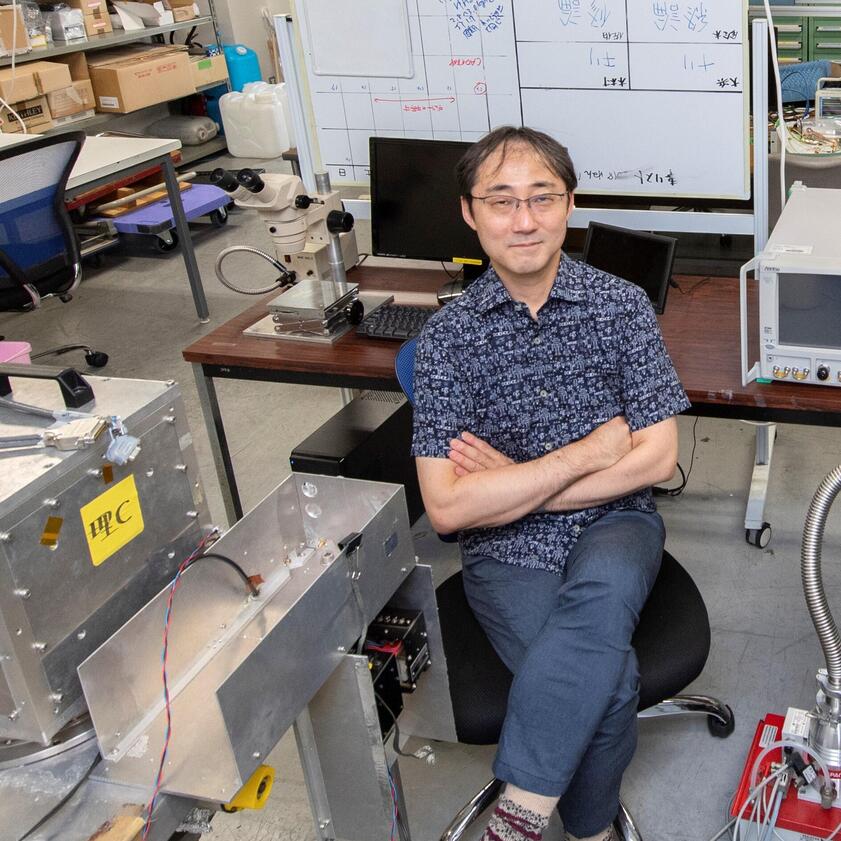Professor Ryuichiro Higashinaka

Researchers'
Associate Professor
Kengo Tachihara
Graduate School of Science
In an interview with Professor Shinya Yamanaka of Kyoto University when he was awarded the Nobel Prize, he said that his teacher told him to "try first before you think, and think only after you get the result." The students who come to the Physics Department are all very smart and can think for themselves very well. However, I have seen them overthink things and lose the ability to move forward. When you try something, you often get an unexpected result. This is the interesting thing about research, even if you do not understand it now. If you keep moving forward without stopping, I believe that one day you will find a clue to the solution in an unexpected place.
I use radio telescopes to observe the universe and study the properties of the dilute gas and dust floating in space. I would like to clarify how these materials are used to form new stars in galaxies and how young stars are born.
Star eggs observed by the ALMA telescope.
These are dense gas condensations,
which are the prime material for the birth of new stars.
Since I was a child, I have always wanted to move a giant mechanical device at will, or to discover something with a telescope that is invisible to the naked eye. When it came time to choose a lab at university, I thought that radio astronomy was exactly what I wanted to do.
The NANTEN2 telescope owned by the Graduate School of Science of
Nagoya University on the Atacama Desert, Chile
The celestial objects I mainly observe are called dark nebulae, and they appear completely dark to visible light. However, something is hidden inside it, and by analyzing radio images, baby stars that were previously invisible can be revealed. Even tens of thousands of light years away, the faint light and radio waves emitted from celestial objects are reaching the earth. If we use the technology we have, point our telescopes, and listen carefully, we can hear the birth of the stars. It is really interesting.
Actually, before ours, an observation similar to the one made in this study was made by ALMA Telescope, and the results said nothing was found. However, in my opinion, that was because of inadequate observation methods and sensitivity, and I was frustrated that the wrong results were taken for granted by many researchers who did not know that. I am glad that we were able to show that correct observations can lead to correct results.
In October 2011, on the first day of the ALMA Early Science Observations,
taken with colleagues from the Joint ALMA Observatory
I had many online meetings and discussions at home, which may have made me more efficient in my use of time. However, chit-chatting and wasting time are also necessary for human beings. On the airplane on my way to a business trip, I realized that time spent disconnected from the outside world also has meaning.
At the end of August, when things were slightly improving, the Perseid meteor shower peaked. At night, my wife and I went to a park with a great view in Nagoya City. It was the first time I had seen a shooting star in Japan in many years.
The Atacama Desert in Chile, where the telescope is located, is at a high altitude and there is a risk of altitude sickness. Fortunately, my body seemed to adapt easily. Still, it seemed to be taking its toll, and I lost several kilos of weight on each business trip. Lately, I have been becoming concerned about my stomach area because of my inability to go to Atacama.
Observations and experiments have stopped worldwide, even in the field of astronomy, but the universe remains as exciting as before. Our telescope in Chile is equipped with the latest instruments, and we are waiting for the resumption of observations. I cannot wait for that day to come!
Name: Kengo Tachihara
Department: Graduate School of Science
Title: Associate Professor
Career history and hobbies:
Graduated from the Division of Particle and Astrophysical Science, Graduate School of Science, Nagoya University in 1999. After working as a researcher at the Max Planck Institute for Extraterrestrial Physics; Japan Society for the Promotion of Science (JSPS) Overseas Research Fellow at the Friedrich Schiller University Jena, Germany; a researcher at Kobe University; and an assistant professor at the National Astronomical Observatory of Japan (NAOJ) as a scientist at the Joint ALMA Observatory, Chile, he has been in his current position since 2013. He conducts observational research on star formation and the interstellar medium, and directs the operation and development of the NANTEN2 telescope.
His hobbies include listening to music and driving.